Japan Wood Products
Prices
Dollar Exchange Rates of
10th January 2013
Japan Yen 87.04
Reports From Japan
Business sentiment in Japan
Business sentiment among large manufacturers
remains extremely low as 2013 begins. The Japanese
Tankan survey released in mid December 2012 painted
a gloomy picture of business sentiment.
The various indices in the Bank of Japan survey of
business represent the views of companies seeing good
business conditions minus those feeling pessimistic.
The December data indicated a sharp drop from minus
3 in the July to September survey.
The data for the last quarter of 2012 recorded the first
double-digit minus figure since March 2010, the lowest
in almost 3 years.
The decline in Japanese business sentiment is
attributed to the global economic slowdown, the strong
yen, strained relations between Japan and China and
the end of most government subsidies for consumer
products, especially automobiles.
The forecast business sentiment does not anticipate any
further slowdown, rather expecting a slight
improvement. This is attributed to expectations that the
global economy will slowly pick up in early 2013
giving a boost to exports.
The new Japanese government has indicated that the
economy is a major priority and has introduced
emergency economic measures to try and stimulate the
stagnant economy.
The stimulus package aims to overcome deflation
through massive investments in public works. The
immediate effect of the new stimulus package,
financed largely through the issue of special
government bonds, has been to drive down the Yen in
the currency market.
The new economic package includes around US$115
billion in central government spending with around
half of this going to increased public works.
Direct support for businesses
In addition to the spending on public works the
government has allocated some 500 billion Yen to help
businesses acquire overseas companies.
The Liberal Democratic Party (LDP) spending
packages are causing concerns that Japan’s public debt
burden, already the highest in the developed world,
could become unmanageable. Many economists are of
the opinion that reforms of the economy would have a
more lasting impact than the stop-start growth that
Japan has experienced over the last decades.
Apparently, the Development Bank of Japan (DBJ), a
state-owned lender, will disburse around 100 billion
Yen to support firms developing new technologies
especially in the renewable energy field.
Japan’s economic stimulus package
The government is pressuring the Bank of Japan to
concentrate its efforts on reversing the current
deflationary cycle in the country by pumping more
money into the economy.
The Japanese government plans to spend most of the
new budget on public works and disaster preparedness
projects, subsidies for companies that invest in new
technology and financial aid to small businesses.
The moves by the new LDP government has already
driven the yen to a 24 month low against the US dollar,
a welcome relief to exporters whose international
competitiveness improves with a weaker currency.
Government targets deflation
In its December 2012 assessment of the current state of
the Japanese economy the government Cabinet Office
reaffirmed that the economy remains weak reflecting
the deceleration in the global economy. In summary:
Exports have fallen moderately recently
Industrial production has continued to decline
Corporate profits remain weak especially for
manufacturers
Business investment has not improved
Firms consider business conditions poor and
remain cautious
The earlier reported improvement in the
employment situation has not been maintained
and some severe negative aspects still remain
Private consumption is almost flat
Recent developments indicate that the
Japanese economy is in a deflationary phase
The Cabinet Office report suggests that the economic
weakness will remain until there is improvement in
overseas economies. However, there is much
uncertainty about recovery in overseas economies and
the downside risks to the Japanese economy remain.
Domestically, reconstruction efforts are propping up
demand.
Government and Bank of Japan to tackle deflation
The Government and the Bank of Japan are forging a
new relationship driven by the new government and
have pledged to make their utmost efforts to overcome
deflation as early as possible and to return to a
sustainable growth path. One aim of the new
government is to address the cycle of Yen appreciation
and deflation.
To address deflation the government has said it will
deploy a broad range of policy measures and it expects
the Bank of Japan to continue powerful monetary
easing. Recently the Bank of Japan decided to increase
its Asset Purchase Programme which had the effect of
driving the Yen lower against major currencies.
Yen weakens significantly
The Japanese Yen has now fallen to a two year low
against the U.S. dollar. The fall was triggered by
statements from the new finance minister who pledged
to weaken the Yen in an effort to boost exports and
therefore help the economy.
The Yen has been weakening against the dollar since
late 2012 due to threats from the LDP that, to end
Japan's recession, chronic deflation and Yen strength it
intended to push the Bank of Japan to ease monetary
measures further.
Japan's finance minister, Taro Aso, has said he is
determined that the new stimulus measures include
strong support for fighting the strength of the Yen
which, at current levels, is a drag on exports.
Unusually direct language during the Japanese general
election campaign and now the confirmation of the
massive government stimulus package has driven the
Yen lower.
Analysts point out however that these moves by the
new Japanese administration could complicate
relations with the US and regional trading partners.
Many Asian countries have been trying to weaken their
currency which strengthened after the US Federal
Reserve and European Central Bank adopted very
loose monetary policies.
The recent moves by the Japanese government is
clearly aimed at helping domestic exporters who have
faced very tough trading conditions for the last two
years because of the strength of the Yen.
The weakened Yen will have an impact in Asia as
other countries will be tempted to follow the lead given
by Japan.
South Korea, Taiwan P.o.C and increasingly China rely
on exports of electronic, automotive and industrial
goods to drive the economy. Because these countries
will loose a competitive edge as the Yen weakens they
may move to weaken their own currencies.
JP Morgan Chase and Co. has recently revised the Yen
projections forecasting a fall to 90 Yen to the dollar in
the second quarter of this year. Nomura Holdings also
reduced its forecast to 90 Yen per dollar for the same
period.
Consumer confidence slips
Consumer confidence in Japan fell in the last quarter of
2012 due mainly to the failure of the government to
come out with coherent policies to create more job
opportunities and bring the economy out of recession.
The latest data suggests that the new government in
Japan is being given credit for some of the bold, some
say reckless, plans it has for increasing public works
projects and the consumer confidence index halted its
downward slide.
Over the coming months consumers will be watching
to see if the Bank of Japan can deliver on its inflation
target, if it does this could possibly result in greater
consumer spending.
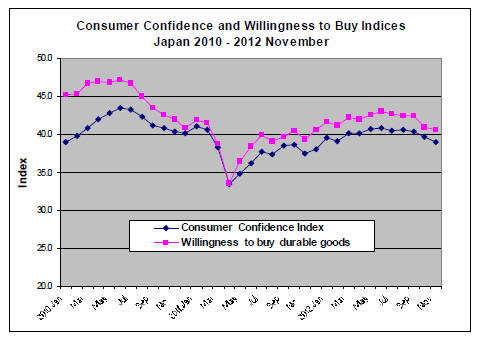
Housing starts in Japan
Data from the Japanese Ministry of Land,
Infrastructure, Transport and Tourism released in
December shows that November housing starts totalled
80,145 units up around 11% year on year and but the
pace of growth is lower than the 25% rise in October.
Owner-occupier units totalled 28,200 (+9%) while
homes built for rent were 30,100 in November (+23%).
Sales of condominiums and houses increased
marginally
The rate of growth in housing starts slowed after the
government's eco-reward programme expired as of
Oct. 31, 2012. Eco reward points were given to owners
of homes built to new energy saving standards.
Annualised housing starts totaled 907,000 calculated
on the basis of the year to November compared to
978,000 based on developments up to October.
The general consensus is for 2012 starts to reach
911,000. However it is reported that construction
orders received by the 50 largest contractors fell 2% in
November, following a steep decline in October.
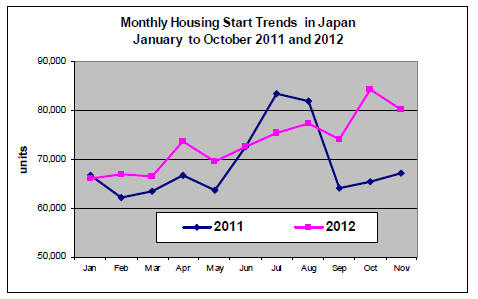
Increase in wooden buildings
The number of new wooden buildings is growing in
Japan especially in the suburbs where fire resistant
standards are not as strict as in the built up areas.
Wooden structures are considered cost-competitive in
Japan especially in one-story construction. Wooden
buildings are now popular for care facilities,
convenience stores and educational facilities such as
schools, nursery schools, and preschools.

Restoration of Seihoku’s damaged plants
(source JLR Dec 21 2012)
Seihoku group’s plants on the North East coast of
Japan suffered considerable damages by the earthquake
and tsunami in March 2011. The plants recovered one
after another and the production is coming back.
Production of coated concrete forming plywood made
by local softwood and particleboard is back on right
track.
Seihoku’s plywood mills have been adjusting
production to maintain supply and demand so that the
mill inventories are less than one month.
Seihoku Plywood mill has started producing coated
concrete forming panel with local softwood since last
July and the production moved up to 50,000 sheets for
October and November. Also five plied 100% cedar 15
mm panel is now tested. There is some concern that
softwood concrete forming panel may cause cracks in
concrete but the mill says there is no such worry.
Plywood
(source JLR Dec 21 2012)
Domestic softwood plywood production in October
was 213,900 cbms and the shipment was 219,500
cbms. Both are the highest monthly record this year.
The inventories have been below 200 M cbms for three
straight months. October’s inventory was 193 M cbms.
Dealers say that November shipment seems higher than
October. The market is very firm.
Current market prices are 730-750 yen per sheet
delivered on 12 mm 3x6 (special type/ 4 star), 10 yen
up from November. 1,550-1,580 yen on JAS 24 mm
3x6. 1,150-1,180 yen on 9 mm 3x10. Both are holding
steady.
Market of imported plywood is also firm. Port
inventories are down while shipment continues busy.
Some warehouse recorded that the November shipment
was the highest since last April.
There are more than 13 ships waiting for unloading at
the port of Yokohama, which may not be unloaded in
this month.
Bullish suppliers’ attitude of Malaysia and Indonesia is
impacting the market in Japan so that the prices
continue edging up.
The market prices for 3x6 JAS concrete forming for
coating are 1,030 yen per sheet delivered, 20 yen up
from November. Concrete forming is 870-890 yen, 10
yen up. 12 mm structural panel is 920-930 yen, 10 yen
up.
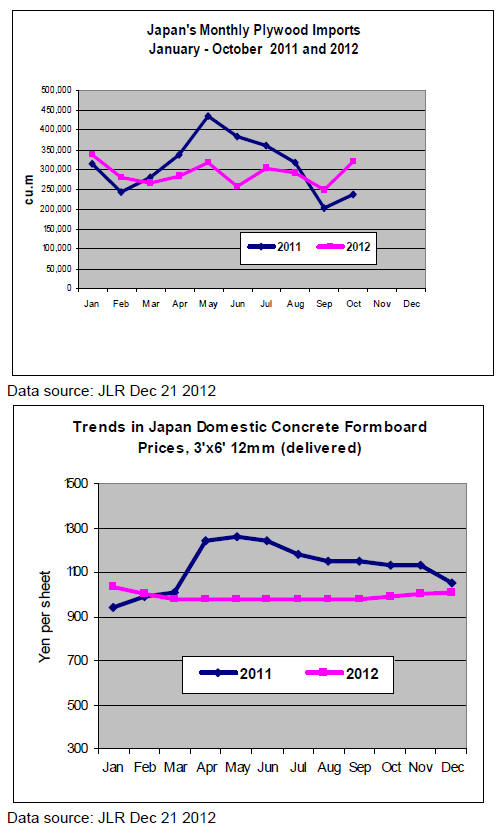
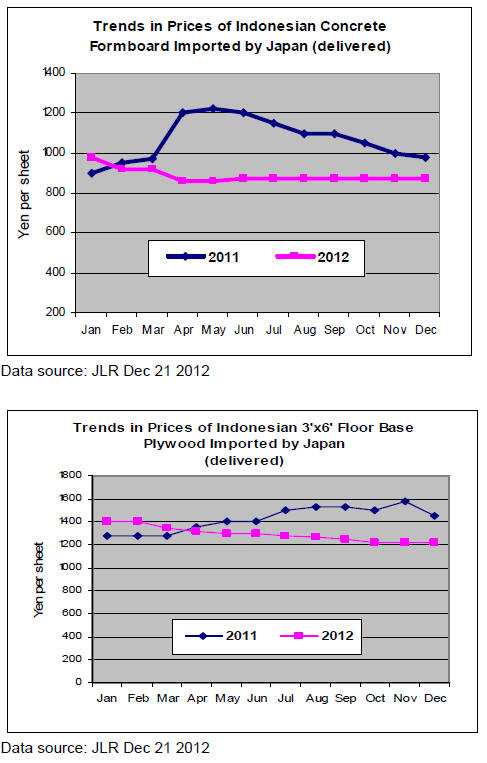
Japan-China Wood Use Promotion Seminar
The Japan Wood-Products Export Promotion Council
and the Japan External Trade Organization (JETRO)
co-organized a seminar titled “Japan-China Wood Use
Promotion Seminar 2012” in Tokyo in this fall. Four
lecturers from Chinese enterprises visited Japan to
introduce completed buildings.
Japan’s furniture imports
Japan’s imports of Office Furniture (HS 9403.30) in
November 2012 totalled Yen 179,896,000, marginally
lower than the Yen 209,187,000 imported in the same
month in 2011 but higher than the Yen 90,695,000
imported in October 2012.
Of imports of office furniture in November 2012
Chinese manufacturers provided Yen 81,909,000 or
around 45% followed by Indonesia with 8%. China’s
exports of office furniture to Japan in November 2012
were almost double that in October 2012.
Japan’s imports of Kitchen Furniture (HS 9403.40) in
November 2012 amounted to Yen 845,786,000,
marginally down on levels in October (Yen
876,267,000). China’s contribution to Japan’s imports
of Kitchen Furniture amounted to Yen 140,098,000
once again placing China third in the rank of supply
countries behind Vietnam (Yen 316,968,000 and
Philippines (Yen 171,083,000).) Both countries
managed to increase exports to Japan.
Indonesian exports of Kitchen Furniture continued but
it appears Indonesian exporters lost ground to exporters
in Vietnam and Philippines.
China’s exports of Kitchen Furniture valued at Yen
140,098,000 in November 2012 were below levels
recorded in November 2011.
Japan’s imports of Bedroom furniture (9403.50) in
November 2012 at Yen 1,452,561,000 were, once
again, higher than levels recorded in November 2011.
China’s contribution to Japan’s imports of Bedroom
furniture in November was Yen 826,005,000, a marked
improvement on levels in October 2012 and higher
than levels in November 2011.
In November 2012, apart from China, the other major
suppliers of Bedroom furniture to Japan were Vietnam
(Yen 317,582,000) and Malaysia (Yen 141,841,000).
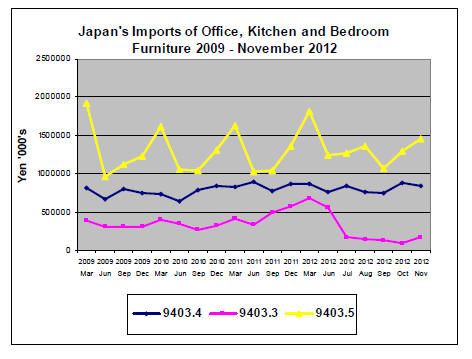
The figure below illustrates the changes in Japan’s
imports of Office, Kitchen and Bedroom furniture in
November 2011 and 2012.
It will be seen that Japan’s imports of Bedroom
furniture from China increased in 2012 compared to
levels in 2011 but for the other products illustrated
declines were recorded.
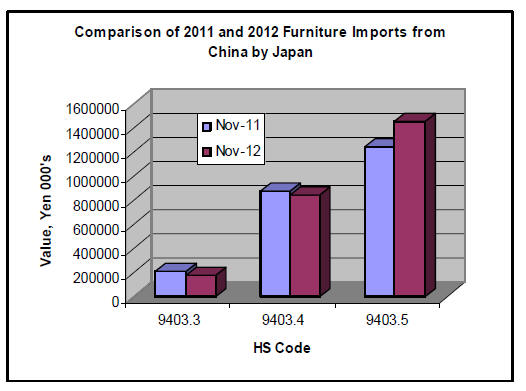
|
